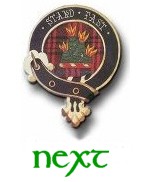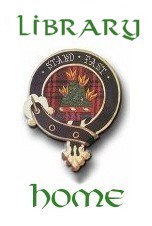

Chapter 9


ABERNETHY, from its central position, is nearly connected with several other districts. This has led in the course of time to a large infusion of people from various clans. Gordons have come from the east, Stewarts, Murrays, and Robertsons from the south, and Mackintoshes, Macphersons, Macdonalds, and Camerons from the west. Cummings, Mackays, Mackenzies, and Macgregors, and other clans have also had their representatives, but the predominant name has for long been that of Grant. Sometimes a family or sept is called after its founder. Thus there are Grants who are called Gabies, after a Gabriel of Lurg. There are Macrobies (Glenlochy) from Robert, Macjockies (Tulloch) or Macooks, from Jock or John, and Macconachies (Gartenbeg) from Duncan, and so on. Other families obtained their name from some peculiarity in appearance, showing the persistency of colour and features. Thus there are Odhar, or dun Grants; Dearg, or red Grants; and Ciar, or grey dusky Grants. The Stewarts of Kincardine were noted for their florid complexion and red hair. Sir Walter, the first of the house, was called the Ridir ruadh, red knight, and the last, three hundred years later, was always known as John Roy, or red. In other cases families were named, and so discriminated, from some remarkable incident connected with their origin. Of these some examples may be given.
Sir Walter connects the story with the murder of Gordon of Brackley by Farquharson of Inveray, commemorated in the well-known ballad " The Baron of Brackley." This tragedy took place in 1666. There was another murder of a Brackley by the Mackintoshes as far back as 1592. Browne, in his History of the Highlands, says—" The Baron was much addicted to hospitality, and, unsuspicious of any bad design against him, he entertained the hostile party in his best manner, but they afterwards basely murdered him." Perhaps there may have been a mixing of these two events, and of others, as often happens, in the ultimate form of the legend. The tradition of the country is that Seumas-nan-Creach, James of the Forays (d. 1553) was the hero of the story, and that the Farquharsons who settled in Strathspey were called, some M’Finlay Roys, others M’Jameses, and so forth. Some of their descendants remain to this day, and are known as the "Race of the Trough," G. Sliochd-an-Amair.
This story is given as narrated by the late William Cameron, Tomgown, Tulloch. Some three or four hundred years ago there were two Atholl men, a Stewart and a Robertson, who had twelve sons each, "under bonnets." The King heard of them, and wished to see them. They set out for Scone. At the gate they disputed as to precedency. The Stewarts claimed to go first, as the King was a Stewart. The Robertsons said they were as good men as the Stewarts, and would not yield. From words they came to blows. The fight was long and bloody. At last but two Stewarts and one Robertson were left alive. Robertson swam the Tay, and roused his clan. The Stewarts had to fly. They crossed the hills to Badenoch, but found no rest. On they came to Rothiemurchus, but still they were not safe. At Coylum they were hard pressed, and thought it best to separate. The one took the low road by the Spey, and the other took the high road by the hills through Tulloch. At Rothiemoon there lived a man who was a turner by trade. He had but one eye, and was called An Tuarncar Càm He was busy at his work. Stewart told him his story. "My life," he said, "is in your hands; save me, if you can." The turner said, "Change coats with me, and get up into my place." This was done. Then the turner went out, and started across the Nethy. The Robertsons, coming up, saw him running, and followed hard in pursuit. At Achernack they came up with him. But, to their disgust, they found that he was old and one-eyed, and not at all the man they sought. They asked angrily why he had run from them. He answered, why had they run after him. He was only in a hurry to do his errand. Then they left him, and turned back. At Rothiemoon, where there was a village ale-house, they rested, and amused themselves by shooting at a mark. The lad of the loom was made to fetch their arrows. He did this for a while, and then said he was tired of fetching and carrying like a dog every time one of them shot. Let them shoot all their arrows, and then he would bring them back in one bundle. This they did. Then Stewart had them at advantage. The result was that they let him off. Stewart married the turner’s daughter. His descendants were called Sliochd-an-tuarncar-chàm, the Stewarts of the one-eyed turner. One of the race, who died lately, was a landed proprietor in the Laich of Moray. The other Stewart kept by the hills. At Landichen he met a farmer driving out dung to his field, with a white mare, in a lòban—the rude wicker cart of those days. He craved for help—" My life is in your hands." The farmer told him to lie down, and then emptied the contents of the cart over him. Soon after the pursuers came up. They asked the farmer if he had seen such and such a man pass. His answer was, "He was here a little while ago. You might seek him yonder by the Laggandubh." They set off in haste, and were seen no more. Stewart was taken to Landichen, and in due course married the farmer’s daughter. His descendants were called Stiubhardaich-an-lòban, the Stewarts of the Lòban, or otherwise S. an-laìr-bhàn, the Stewarts of the White Mare. They are said to have held the farms of Landichen and Lethnachyle for three hundred years. The head of the family, as appears from Session records, was generally an elder of the Church, and come of their descendants have done good service to their country. The late Mr John Stewart, who died at Springfield, near Forres, in 1847, and whose career is traced in another chapter, was one of them.
The families of Achernack, Gartinbeg, and Tulloch belonged probably to the original inhabitants, and took the name of Grant when the Laird of Freuchie became supreme in the country. In the Gartenmore MS., 1747, it is said that it was the custom of the chiefs to oblige "all the farmers and cottars that got possessions on their grounds to take their names. In a generation or two, it is believed that they really are of that name, and this not only adds to the number of the clan, and keeps it up, but superinduces the tye of kindred to the obligation and interest of the former." There was a John McConquhy or Macconachie Grant at Gartinbeg in 1537, and from him came the Grants of Kinveachy, Balintomb, Inverlaidnan, and Delrachny. James Grant, advocate (1686), who obtained a Nova Scotia Baronetcy in 1688, and afterwards purchased the lands of Dalvey, was of this family. The present representative of the Dalveys is Sir Ludovic James Grant, Professor of Public Law in the University of Edinburgh.
The family of Achernack, Clan Allan, had their first home at Dunan, near Castle Grant, which was sold to John. Grant of Freuchie in 1589. There is a bond of service by James Grant of Achernack to James Grant of Freuchie in 1655. This James Grant was Chamberlain of Grant, and it was he who arrested and took to Edinburgh (1660) the famous raider "The Halkit Stirk." In 1777 the Chieftainship, with all rights appertaining, was by deed and in presence of the Lyon Depute, transferred by "Neil Grant, eldest lawful son of the deceased John Grant in Lincorne, and nephew to Duncan Grant of Achernack, who died in the month of October last without male issue," to his cousin, Dr Gregory Grant, physician in Edinburgh. The motto of the Achernack Grants was "Stand Sure" (Craigrevack). The two-handed sword that belonged to Achernack, as Chamberlain, is in the possession of Miss Grant, Achernack Cottage, Forres, the last surviving member (aged 98) of the family of Colonel Grant of Achernack.
are descended from Robert Grant of Glenlochy in this parish. In 1620 (30th April), Donald Grant McAlister vic Robie, grandson of Robert, renounced the Wadset of Glenlochy with M’Eagle’s croft, mill and mill lands thereof, in favour of John Grant of Freuchie, for the redemption money of 500 merks, and on the following day received from him a wadset of an annual rent of £40 Scots to be uplifted from the lands of Glenlochy. He was succeeded by his son Alister. Then followed Gregor, John, Patrick; and then another Patrick, who married Beatrix, daughter of Donald Grant of Inverlochy, and was father of John Grant, who studied for the English Bar, was afterwards Chief Justice of Jamaica, and on his retirement purchased the estate of Kilgraston. John Grant having no issue, was succeeded by his brother Francis, who became the progenitor of the Kilgrastons. Two of his sons attained high eminence, the one in art, the other in arms—Sir Francis Grant, who was President of the Royal Academy, and General Sir James Hope Grant, G.C.B., who distinguished himself greatly in China and India.
Rinn an t-Seanar dùn,
Thog am Mac tùr,
‘S rnhùn an t-Ogh E.
i.e., the grandfather made a pile, the son built a house., and the grandson spent all. The grandson made himself obnoxious by his zeal in recruiting, and his dissolute life. He died in the Sanctuary at Holyrood, 21st December, 1821. There are two anecdotes of old "Stacan" worth preserving. On one occasion he had a quarrel with Balliemore, and, it is said, wounded him severely. For this he was fined, and, when paying the money, he said, with grim humour, Bu chòir dhomh a chnàmhaig fhaighean do phaigh mi an eiric, I should surely get the remains since I have paid the ransom. There had for long been a keen dispute between Lurg and others as to the site of the mill, which was at last settled by the mill being set up in the Garlin. "Stacan" was much vexed at this, and one day that he was visiting a neighbour, who was on his death-bed, he said to him as a message to his father in the other world—Innis dha ‘m athair, ciomar tha sinn uile gu leir, agus gu bheil Muilinn na-h’ abhainn ruadh bleith min ‘sa Gharlinn, Tell my father how we all are, and that the Mill of the Redburn is making meal at the Garlin. Mrs Grant of Laggan tells that such messages by dying people to departed friends were not uncommon in the Highlands. There is a curious story of the kind told of the late Rev. Rowland Hill. Once, on a preaching excursion, he suddenly exclaimed, "I must go to Cambridge, and see the widow of an old clergyman, who is living there, for I have a message to leave with her." He was asked if the message was important, and replied, "Yes, sir, I want the old lady, who will soon be in heaven, to give my love! to Johnny Stittle, and to tell !him I shall soon see him again." Hill’s message, though marked by his usual oddness, was somewhat more spiritual than that of "Old Stacan."
 |
 |
Chapter 9 |
 |

|